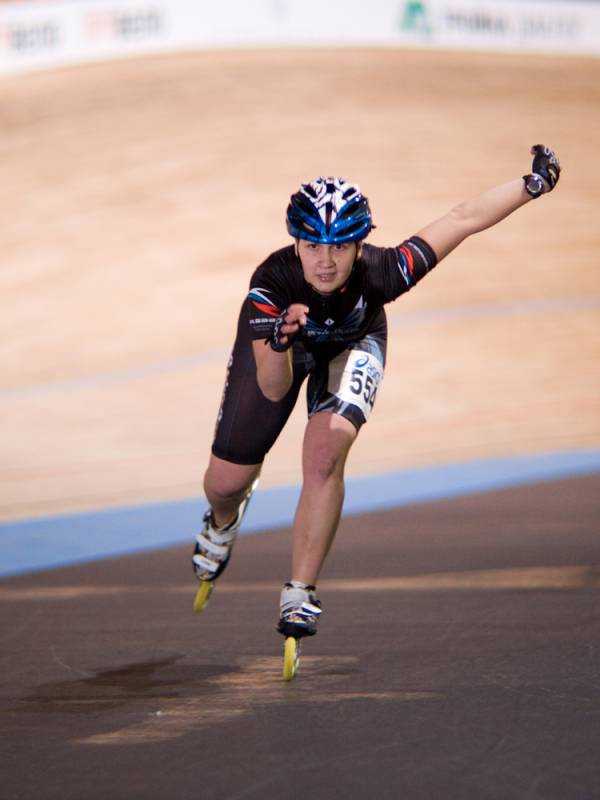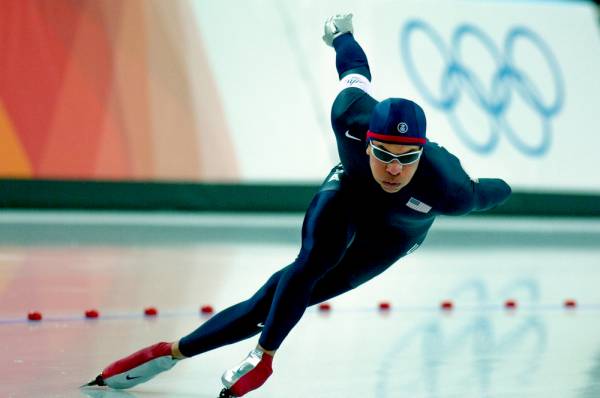If you weren’t impressed by speed skating at the Olympics this year, then you must not have been watching. I know I was impressed, and it led me to want to learn all I could about where that speed (and those incredible legs) came from. As a strength and speed fanatic (and coach), I am a big fan of strength and conditioning, plyometric work, and power training. I knew there had to be a killer combination of all of the above to get these athletes to move those massive legs at top speeds and around very tight corners.
Speed skating requires so much more than just the ability to skate. As the name suggests, speed is the real key. But first, the sport requires a well-developed predominant muscle type in order to be fast and competitive, i.e. fast twitch muscle fibers. On top of that, skating takes a tremendous amount of lower body strength, core and back strength, ankle strength and flexibility, and balance (in more ways than one). So, first comes genetics and second comes training.
The Training
Just as in any sport, even if an athlete is blessed with the genetics, he or she must still be trained. The best in the sport are those who train the hardest and train consistently. They also have to skate fast – plain and simple. Most serious or competitive speed skaters skate fast in training, train in the weight room, and use track and plyometric work to enhance power, strength, and speed.
 Contrary to what you might think while watching the Winter Olympics, much of speed skating training takes place off the ice and on dry land, in both gym and track settings. As I did my research, I noticed a lot of commonalities between track and speed skating training, but I also saw some subtle differences. The speed skating training involved a slightly different (and sport-specific) technical approach, but it still utilized the same means-to-an-end to develop optimal power, explosiveness, endurance, and flexibility. This is great news for those who might not have access to ice, a rink, or a skate training facility. It means you can train like a speed skater anywhere. And I mean anywhere. Tracks, hills, fields, trails, stairs, and just about anywhere else if you use some imagination.
Contrary to what you might think while watching the Winter Olympics, much of speed skating training takes place off the ice and on dry land, in both gym and track settings. As I did my research, I noticed a lot of commonalities between track and speed skating training, but I also saw some subtle differences. The speed skating training involved a slightly different (and sport-specific) technical approach, but it still utilized the same means-to-an-end to develop optimal power, explosiveness, endurance, and flexibility. This is great news for those who might not have access to ice, a rink, or a skate training facility. It means you can train like a speed skater anywhere. And I mean anywhere. Tracks, hills, fields, trails, stairs, and just about anywhere else if you use some imagination.
Here are some great exercises to help you train like a speed skater. Please be smart, modify as needed, start slow, and most importantly, focus on technique and progression of movement.
Track and Plyometric Training
Plyometrics are important in increasing dynamic speed, power, and agility (not to mention ankle strength and flexibility). Some of my favorites here are much like the track drills I use with my own athletes and include low-walks, lunges, bounding work, stair work, skaters, single-leg or double-leg hops, jumps, drops, lateral and diagonal drills, and several others along all planes of motion. Jump rope work is also great for ankle strength, speed, and agility, as are ladder drills. So make good use of all of those no matter what your training regimen or sport might be.
Strength Training
 Weight training for speed skaters is not all that different from what you see in other athlete strength programs. The key for skaters is to build up strong legs and core. They also put quite a bit of emphasis on balance. As for the legs, squats of several varieties are important, as are leg extensions and hamstring curls (and so much more). The upper body work is also important and typically includes a tremendous amount of midline work. It is typical to see these athletes utilize some basic strength programming including supersets and dropsets in different capacities and arrangements.
Weight training for speed skaters is not all that different from what you see in other athlete strength programs. The key for skaters is to build up strong legs and core. They also put quite a bit of emphasis on balance. As for the legs, squats of several varieties are important, as are leg extensions and hamstring curls (and so much more). The upper body work is also important and typically includes a tremendous amount of midline work. It is typical to see these athletes utilize some basic strength programming including supersets and dropsets in different capacities and arrangements.
Speed Skating Specific Training
In a sport where the gap between a gold medal and no medal is an average of 1.3% difference in time and the difference between gold and silver is only 3/10 of a percent, you have to be good. Despite all the off-ice training, you need to be comfortable on the ice when you get back on it. To do this athletes simulate and build up the similarities that transfer over.
Here are three simulation exercises I found that just about anyone can do or try:
1. Dry-Land Skating – Specialty inline skates can be pretty pricey, so just pull those old rollerblades out of the garage and give this a shot. Little by little begin to work on the techniques of speed skating by getting comfortable on your dry-land skates first.
2. Slideboard – As so much of speed skating involves lateral movement, there really isn’t much out there on the market or in training exercises to simulate this more rare (and usually very underdeveloped) directional movement. The slideboard comes in handy in this capacity, and it also helps with aerobic work while engaging muscles not typically targeted or used by the average person.
3. Turn Cable – The speed skating turn cable is also another great way to work on lateral movement, technique, and to build strength through the legs and core especially. When done properly, the entire body is engaged and that includes the upper body, arms, and low back. For the longer track skater, repetitions of turn cables play a huge role in building lactic acid capacity. The biggest help here for the skater is of course to nail the turns but everyone can benefit greatly here.
The next Olympics is in four years, so if you want to have the power, speed, and legs of these amazing athletes, then you better get to it!
References:
1. “Thunder thighs made of pure muscle,” Fox Sports on MSN Canada, accessed Feb 15, 2014.
Photos courtesy of Shutterstock.






